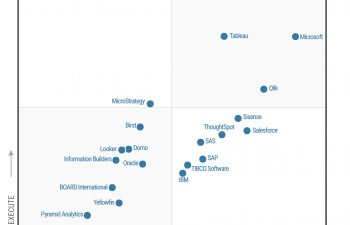Published on the 21/03/2018 | Written by Jonathan Cotton

MS continues to outperform BI peers with slick product, great iteration and an attractive price point…
In 2018 we seem to be witnessing the rise of something like an Analytics Economy, as clever analytic and BI platforms – and cloud deployments of the same – move well and truly into the mainstream. With prices low and capabilities improving, there is a ready market of enterprises looking to either perform well overdue upgrades to their BI capabilities or expand their suites to include new innovation.
And according to Gartner (and its Magic Quadrant for Analytics and Business Intelligence Platforms) at this moment in time Microsoft is the clear-best-in-show, performing well beyond its nearest rivals. Microsoft occupies the most upper right ‘Northeastern’ position of this year’s quadrant, the clear leader in terms of ‘Completeness of Vision’ (as it has been for years) and sharing first place on ‘Ability to Execute’ with Tableau.
Figure 1. Magic Quadrant for Analytics and Business Intelligence Platforms
Source: Gartner (February 2018)
“Microsoft is positioned in the Leaders quadrant again this year, with continued strong uptake of Power BI, and high levels of customer interest and adoption,” says the report.
“Microsoft has a clear and visionary product roadmap that includes vertical industry content.”
Gartner places Microsoft in the top quartile for ease-of-use, with 14 percent of customers citing that that was their main buying criterion with Power BI. Although Microsoft doesn’t release actual numbers, Microsoft Power BI has a large user base, thanks to some savvy enterprise software agreements and low price point.
Power BI Pro’s list price is US$9.99 per user per month, making it one of the lowest-priced solutions on the market today. One could argue that that low price is creating downward price pressure on the market and producing some degree of ‘democratisation’ of BI and analytic technology, as SMEs increasingly look to enjoy some of the insights that data analysis can bring.
From a product standpoint, Microsoft Power BI offers data preparation, discovery, interactive dashboards and augmented analytics and is available as a SaaS option in the Azure cloud or via the on-premises Power BI Report Server (the latter however lacking some of the machine-learning capabilities found in Power BI SaaS). Power BI Desktop can be used as a stand-alone, free personal analysis tool. Last year the company introduced Power BI Premium – with a starting price of just under US$5k per month (dependent on scalability and usage requirements) – which acts as a virtual server in the cloud and provides greater storage and data refresh capabilities.
Collecting and responding to user feedback has clearly been a priority for Microsoft. Several years of iteration has seen the product evolve alongside user feedback, with the company doubling down on its own data collection with the Power BI Ideas Forum – a forum created last year which has generated a passionate and engaged community.
Last year the company brought Quick Insights – already featured within Power BI – to its desktop offering. A form of augmented data discovery, Quick Insights lets users perform variance analysis – identifying what has most contributed to certain changes over time. Virtual reality and Power BI integration with Hololens are also said to be works currently in progress.
Great interfaces and sweet visuals count for little if you can’t put bums on seats however and it’s here Microsoft is doing best, communicating clearly the benefits of its product and making good on its “five by five” UX strategy (“five seconds to sign up and five minutes to ‘wow’”). Combine that with strong partners and a passionate user community and you’ve got Microsoft’s position on Gartner’s BI and Analytics Magic Quadrant.
Simply put, Microsoft is making better information available, more easily and at a low price point and that’s a tough combination to beat.




























